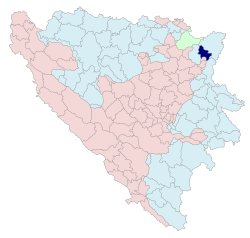Ugljevik
|
Ugljevik Угљевик |
||
|---|---|---|
| Municipality | ||

Main Street in center of municipality, Karadjordjeva street
|
||
|
||
 Location of Ugljevik within Republika Srpska |
||
| Coordinates: 44°41′40″N 18°59′52″E / 44.69444°N 18.99778°E | ||
| Country | Bosnia and Herzegovina | |
| Entity |
|
|
| Government | ||
| • Načelnik | Vasilije Perić ((SDS) [1]) | |
| • Municipality Assembly Speaker | Slobodan Zarić | |
| Area | ||
| • Total | 165,17 km2 (6,377 sq mi) | |
| Population (2013 census) | ||
| • Total | 16,538 | |
| • Density | 100,13/km2 (25,930/sq mi) | |
| Time zone | CET (UTC+1) | |
| • Summer (DST) | CEST (UTC+2) | |
| Postal Code | 76330 | |
| Area code(s) | (+387) 55 | |
| Website | http://www.opstinaugljevik.net | |
Ugljevik (Serbian Cyrillic: Угљевик) is a municipality and town in Republika Srpska, Bosnia and Herzegovina. The municipality located in the eastern foothills of Mount Majevica, in picturesque countryside, where wondrous and beautiful mountain starts descending towards the flatlands of Semberija, to which it is tied more than any other surrounding area. The center of the municipality is the town of Ugljevik, the most sunbathed and modern of communities in the Republika Srpska entity. This is the home of miners and other energy resource professionals.
Ugljevik was named for the coal, which began to be organizely exploited on Mount Majevica in 1899.
Coal production has been exploited on Mount Majevica since 1899. Within a century, the Majevicans developed the initial small dig into today’s surface mine producing 6,000 tonnes of coal per day and the coal-fired power plant “Termoelektrana Ugljevik” (Ugljevik Power Plant), supplying the Republic with 300 megawatts of electricity. Preparations are underway for the construction of another power-plant of 600 MW. Exploration indicates huge reserves of quality coal, with seams stretching in every direction, even reaching Zvornik on the Drina river. The administrative center of the Municipality was the village of Zabrdje, to be transferred to the mining community of Ugljevik (now named Stari Ugljevik (Old Ugljevik)) in 1941, after Zabrdje was burned by Ustaše. The present-day Ugljevik began to be built in 1980 in the valley of Janja river (one of the Drina’s tributaries) between Zabrdje, Stari Ugljevik, Bogutovo Selo and Ugljevicka Obrijez, in answer to the need for increasing the surface mining operations and building the power-plant. The whole of the old Ugljevik was then moved to this new site.
...
Wikipedia

